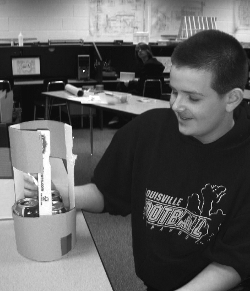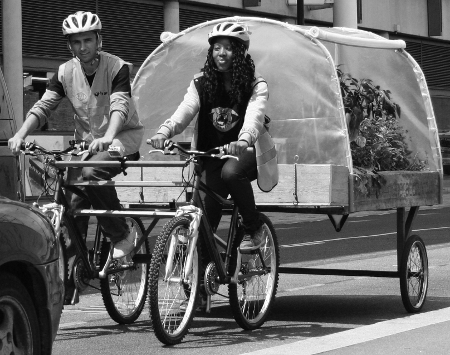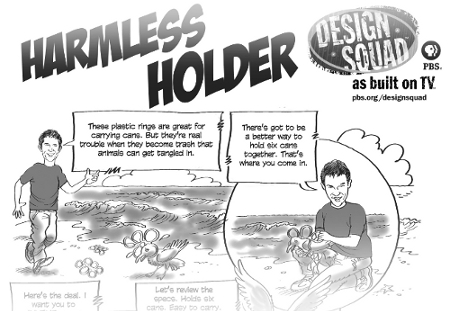Lesson: Harmless Holder
 (Lesson from PBS’s “Design Squad Nation.” Download the original lesson in pdf form and find more activities like this on the Design Squad Nation resource page.)
(Lesson from PBS’s “Design Squad Nation.” Download the original lesson in pdf form and find more activities like this on the Design Squad Nation resource page.)
Summary
In this activity, teams of kids in grades 4 – 7 follow the engineering design process to invent a holder for six cans that’s animal-safe, sturdy, convenient, and easy to carry. They learn why discarded plastic rings can be a problem for wildlife and brainstorm animal-friendly ways to package six cans. They then build, test, and redesign their system and discuss what happened.
Grade level: 4 – 7 (9- to 12-year-olds)
Time: 30 – 60 minutes
Learning Objectives
After completing this activity, students should have a better understanding of:
- Engineering materials
- Engineering design
- Planning, construction, and testing
- Teamwork
Learning Outcomes
As a result of this activity, students should develop an understanding of:
- engineering and design
- problem solving
- teamwork
Standards
National Science Education Standards
- Science as Inquiry [K-4]
- Properties of Materials [K-4]
- Technological Design [K-8]
- Technology in Society [5-8]
International Technology Education Association
- C. The use of technology affects the environment in good and bad ways. [Grades 3 – 5]
- D. Identify and collect information about everyday problems that can be solved by technology, and generate ideas and requirements for solving a problem. [Grades 3 – 5]
Materials (per team)
- 6 full cans of soda, seltzer, or juice
- cardboard (approx. 8.5 x 11 in.)
- copier paper
- duct tape
- wax paper
- string
- 4 paint stirrers
- 6 rubber bands
The Challenge:
Invent a holder for six cans that’s animal-safe, sturdy, convenient, and easy to carry. 
Procedure
1. Prepare ahead of time
- Read the leader notes and challenge sheet.
- Get one or two plastic six-pack rings.
- Gather the materials.
- Have sponges and towels on hand in case of spills.
2. Introduce the challenge (5 minutes)
To grab kids’ attention, read the following story:
It was getting all too common along the beach where she lived. Birds and turtles washing up on the shore, tangled in the plastic rings used to hold drink cans together. Up ahead was just such a bird. Fortunately, it would live. With a snip of the girl’s scissors, the plastic ring that was strangling the bird fell off. You know those plastic rings, the ones for carrying packs of soda cans. They may be strong, light, and easy to carry. But the trouble begins when they become trash.
3. Warm up: Check out a plastic holder (10 minutes)
Pass around some six-pack holders and ask:
- How strong are the rings? How big? How stretchy? How easy to use?
- What are some advantages and disadvantages of plastic? (Plastic is strong, waterproof, lightweight, easily molded, flexible, durable, inexpensive. But when it’s thrown in the trash, it never biodgrades, as paper, string, and wood do.)
- Who would benefit from, or be interested in , having safe six-pack holders? (Animals, of course, and manufacturers who want to offer a safe product, environmentalists, animal-rights groups, and consumers who buy “green” products.)
Tell kids that animals get tangled in these plastic rings and can’t get free. To have them experience this situation, have each kid slip a rubber band loosely onto his or her right wrist. Ask them to try to remove it, using only their right hand. No fair using another body part, such as teeth or their left hand!
4. Brainstorm design ideas (10 minutes)
To help kids brainstorm, show them the materials, discuss the questions below, and have them sketch some design ideas.
- The cans in a six-pack are all the same size and shape. Name some other containers that hold objects that are the same size and shape. (Egg cartons, breakfast trays, fruit cartons, a cash register drawer, took racks, pencil holders, etc.)
- You need to be able to carry the cans easily. What are some different kinds of handles used to pick up objects? (Luggage handles, backpack straps, wheelbarrow handles, tops of milk cartons, etc.)
- How can you hold six cans together? Do the cans have to sit in two rows of three? (No. Kids can stack their cans or set them on their sides.) Should you arrange the cans on end? On their sides? Stack them?
- How can you keep cans together? (Tie them together, loop them with rubber bands, stick them with tape, set them on a trays made of cardboard or paint stirrers.)
- How will you remove the cans easily? How will you take one can out of your holder while still keeping the other five together? (Leave and opening or make a way to pull the cans apart.)
- How will you carry the holder?
- Cans are heavy and will put a lot of force–pushes and pulls–on your holder. What are some ways a holder can resist such forces? (Using sturdy materials, reinforcing joints where parts join together, reinforcing places where the cans put stress on the holder.)
Click for full cartoon.
5. Test, evaluate, redesign (25 minutes)
To learn about the design’s strengths and weaknesses, inventors build a series of early designs, called prototypes. What have you got so far? Think about how you are going to keep the cans from falling off. Any plans for using other materials?
NOTE: If your holder’s bending and twisting, that’s FORCE at work, pushing and pulling on the parts. You need to reinforce things to resist the force.
Here are some problems your designers might face:
- Six cans are too heavy for a design. Even though a kid may have a good idea, it still might not support six full cans. They can strengthen their design by reinforcing the sides or corners with cardboard, adding a layer of tape, or cutting slots and inserting materials.
- The holder collapses when a can is removed. Some designs use cans as part of the support system. When a can is removed, the holder caves in. Point out what’s happening and encourage kids to find ways to strengthen the holder so it doesn’t rely on cans.
- A can ruptures. Keep spare cans for students to use, along with towels and sponges to wipe up spills.
- Kids want to drink the soda. If you don’t want kids to drink the soda, tell them you need the cans for another session, or use cans of a drink they probably won’t like, such as tonic water or seltzer.
6. Discuss What Happened (10 minutes)
Ask students to present, compare, and discuss the prototypes they built today.
- Which features worked best for holding cans together? Picking them up? Carrying them?
- Which design is sturdiest? Lightest? Simplest? Uses the fewest materials?
- Your design had to withstand bending, twisting, and pushing. How well did you design resist these forces?
- What are some ways an improved holder could help the environment? (An improved holder reduces litter, eliminates the dangers to animals, and if the design is reusable, reduces the need for raw materials.)
- If an animal were to eat some of the materials you used today, it might still cause problems. How are these problems similar to or different from the problems caused by plastic six-pack holders.
Modifications
- For younger students, encourage a group brainstorm. Consider offering an additional sheet of cardboard. Since younger kids might have difficulty tearing duct tape, have pre-cut pieces ready ahead of time.
- For older students, limit their materials; challenge them to use fewer materials such as cardboard, paint stirrers or tape.
Resources
Video:
- DIY Harmless Holder – Adam and Judy try the activity in a short video—0:47
- Design Squad Nation Episode: Garden-to-Go – Judy and Adam travel to London to two young members of Global Generation — 28:40

- Eco-Electronics—Erin Gately. Industrial engineer Erin Gately creates new environmentally friendly products for Hewlett-Packard by ensuring that HP’s computer products are made with fewer non-recyclable materials–2:46
- Design Squad Hero Jen Chua, a package engineer for Method cleaning products. – 2:19
- Design Squad Hero Pete Bethune who explores biodiesel fuel for his souped up powerboat – 1:00
Print:
- Harmless Holder graphical project guide (English pdf)
- Harmless Holder graphical project guide (Spanish pdf)
Meet Jen Chua, a package design engineer for Method cleaning products [2:19]
[youtube]http://www.youtube.com/watch?v=POVCe_Plcso[/youtube]
Filed under: Class Activities, Grades 6-8, Grades 6-8, Grades K-5, Grades K-5, Lesson Plans
Tags: Class Activities, design process, Design Squad Nation, Environmental Engineering, environmental protection, Grades 6-8, Grades K-5, plastic rings, six pack, wildlife









